Littoral Drift Impoundment at a Sandbar Breakwater: Two Case Studies along the Bight of Benin Coast (Gulf of Guinea, West Africa)
Abstract
:1. Introduction
- A reduction in the overall construction cost and a significant decrease in project execution time due to the minimal need for hard structure installations and the availability of large magnitudes of longshore sediment transport.
- A decrease in quarrying activities and transportation, subsequently reducing air pollution, accidents, and carbon emissions.
- Effective wave sheltering by the shortened groynes reduces the wave energy entering the main port basin.
2. Study Areas
2.1. Port of Lomé, Togo
2.2. Lekki Deep Sea Port (Dangote Sea Port), Nigeria
2.3. Oceanographic Settings
3. Materials and Methods
3.1. Shoreline Detection
3.2. Shoreline Change Analysis
3.3. Longshore Sediment Transport
3.4. Depth of Closure and Berm Height
4. Results
4.1. Case Study 1: Port of Lomé
4.2. Case Study 2: Lekki Deep Sea Port (LDSP), Nigeria
4.3. Impounded Longshore Sediment Transport
4.4. Comparisons with Other Sediment-Accreting Landforms
5. Discussions
5.1. Summary of Case Studies
5.2. Influence of River Sediment Supply and Wave Climate
5.3. Sediment Transport around Ports in Other Coastal Areas
5.4. Lessons for Future Coastal Management
- Continuous adoption of sustainable and modern technologies in coastal infrastructure.
- 2.
- Creating and promoting a unified coastal network for knowledge sharing and joint field surveys to minimize over-dependence on global datasets.
6. Conclusions
Author Contributions
Funding
Institutional Review Board Statement
Informed Consent Statement
Data Availability Statement
Conflicts of Interest
References
- Moraes, R.P.L.; Reguero, B.G.; Mazarrasa, I.; Ricker, M.; Juanes, J.A. Nature-Based Solutions in Coastal and Estuarine Areas of Europe. Front. Environ. Sci. 2022, 10, 829526. [Google Scholar] [CrossRef]
- Davis, M.; Krüger, I.; Hinzmann, M. Coastal Protection and Suds-Nature-Based Solutions: Policy Brief No.4; Ecologic Institute: Berlin, Germany, 2015. [Google Scholar]
- Slinger, J.; Stive, M.; Luijendijk, A. Nature-Based Solutions for Coastal Engineering and Management. Water 2021, 13, 976. [Google Scholar] [CrossRef]
- de Boer, W.P.; Slinger, J.H.; wa Kangeri, A.K.; Vreugdenhil, H.S.I.; Taneja, P.; Appeaning Addo, K.; Vellinga, T. Identifying Ecosystem-Based Alternatives for the Design of a Seaport’s Marine Infrastructure: The Case of Tema Port Expansion in Ghana. Sustainability 2019, 11, 6633. [Google Scholar] [CrossRef]
- European Sea Ports Organisation. The ESPO Green Guide; Towards Excellence in Port Environmental Management and Sustainability; EcoPorts: Brussels, Belgium, 2012. [Google Scholar]
- PIANC. “Sustainable Ports”: A Guide for Port Authorities; PIANC Secrétariat Général: Brussels, Belgium, 2014. [Google Scholar]
- de Boer, W.; Mao, Y.; Hagenaars, G.; de Vries, S.; Slinger, J.; Vellinga, T. Mapping the Sandy Beach Evolution around Seaports at the Scale of the African Continent. J. Mar. Sci. Eng. 2019, 7, 151. [Google Scholar] [CrossRef]
- Wu, W. Coastline Evolution Monitoring and Estimation—A Case Study in the Region of Nouakchott, Mauritania. Int. J. Remote Sens. 2007, 28, 5461–5484. [Google Scholar] [CrossRef]
- Manohar, M. Sediment Movement at Indian Ports. Coast. Eng. Proc. 1960, 1, 21. [Google Scholar] [CrossRef]
- Poulos, S.; Chronis, G. Coastline Changes in Relation to Longshore Sediment Transport and Human Impact, along the Shoreline of Kato Achaia (NW Peloponnese, Greece). Mediterr. Mar. Sci. 2001, 2, 5–13. [Google Scholar] [CrossRef]
- Samsami, F.; Haghshenas, S.A.; Soltanpour, M. Physical and Rheological Characteristics of Sediment for Nautical Depth Assessment in Bushehr Port and Its Access Channel. Water 2022, 14, 4116. [Google Scholar] [CrossRef]
- Griggs, G.B. Littoral Cells and Harbor Dredging along the California Coast. Environ. Geol. Water Sci. 1987, 10, 7–20. [Google Scholar] [CrossRef]
- Jean-Baptiste, K.A.; Atcha, A.D.; Damien, K.A.K. Comparative Analysis of DSAS and MobiTC in Coastal Coastline Dynamics of Baguida and Agbodrafo Cantons (South-East Togo) from 1986 to 2017. Int. J. Comput. Trends Technol. 2018, 56, 32–37. [Google Scholar] [CrossRef]
- Wang, X.H.; Andutta, F.P. Sediment Transport Dynamics in Ports, Estuaries and Other Coastal Environments. In Sediment Transport Processes and Their Modelling Applications; Manning, A.J., Ed.; InTechOpen Limited: London, UK, 2013; Volume 11, p. 35. [Google Scholar] [CrossRef]
- Bruun, P. The Development of Downdrift Erosion. J. Coast. Res. 1995, 11, 1242–1257. [Google Scholar]
- Kim, I.H.; Lee, J.L. Changes in the Sediment Transport Pattern after Breakwater Extension at Anmok Port, Korea. J. Coast. Res. 2007, 50, 1046–1050. [Google Scholar]
- Naik, D.; Kunte, P.D. Impact of Port Structures on the Shoreline of Karnataka, West Coast, India. Int. J. Adv. Remote Sens. GIS 2016, 5, 1726–1746. [Google Scholar] [CrossRef]
- Bosboom, J.; Stive, M.J.F. Coastal Dynamics; Delft University of Technology: Delft, The Netherlands, 2023. [Google Scholar] [CrossRef]
- Di Natale, M.; Di Ronza, S.; Eramo, C.; Vigliotti, M.; Ruberti, D. A Sediment Trap to Mitigate Port Silting Due to Longshore Transport. The Case of Pinetamare Marina (Southern Italy). J. Coast. Conserv. 2017, 21, 803–812. [Google Scholar] [CrossRef]
- Schoonees, J. Annual Variation in the Net Longshore Sediment Transport Rate. Coast. Eng. 2000, 40, 141–160. [Google Scholar] [CrossRef]
- van der Spek, B.-J.; Bijl, E.; van de Sande, B.; Poortman, S.; Heijboer, D.; Bliek, B. Sandbar Breakwater: An Innovative Nature-Based Port Solution. Water 2020, 12, 1446. [Google Scholar] [CrossRef]
- Moesker, N. Sandbar Breakwaters: Analysis of the Effects of Variations in Wave Climate on the Morphological Development of Sandbar Breakwaters by Using the Lekki Sandbar Breakwater Case Study. Master’s Thesis, Delft University of Technology, Delft, The Netherlands, December 2019. [Google Scholar]
- Peters, J.H.J. The Determination of the Feasibility of a ‘Sand Breakwater’ on the Nigerian Coastline at Badagry. Master’s Thesis, Delft University of Technology, Delft, The Netherlands, March 2018. [Google Scholar]
- Mlambo, C. The Impact of Port Performance on Trade: The Case of Selected African States. Economies 2021, 9, 135. [Google Scholar] [CrossRef]
- African Development Bank. African Development Report: Ports, Logistics, and Trade in Africa; Oxford University Press: New York, NY, USA, 2010. [Google Scholar]
- African Union. Maritime Transport: Increasing African Ports Capacity and Efficiency for Economic Growth; African Union: Addis Abba, Ethiopia, 2017. [Google Scholar]
- U.S. Army Corps of Engineers (USACE). Longshore Sediment Transport. In Coastal Engineering Manual; EM 110-2-1100; U.S. Army Corps of Engineers: Washington, DC, USA, 2002. [Google Scholar]
- Almar, R.; Kestenare, E.; Reyns, J.; Jouanno, J.; Anthony, E.J.; Laibi, R.; Hemer, M.; Du Penhoat, Y.; Ranasinghe, R. Response of the Bight of Benin (Gulf of Guinea, West Africa) Coastline to Anthropogenic and Natural Forcing, Part1: Wave Climate Variability and Impacts on the Longshore Sediment Transport. Cont. Shelf Res. 2015, 110, 48–59. [Google Scholar] [CrossRef]
- Laïbi, R.A.; Anthony, E.J.; Almar, R.; Castelle, B.; Senechal, N.; Kestenare, E. Longshore Drift Cell Development on the Human-Impacted Bight of Benin Sand Barrier Coast, West Africa. J. Coast. Res. 2014, 70, 78–83. [Google Scholar] [CrossRef]
- Aagaard, T.; Anthony, E.J.; Gillies, B.; Laursen, S.N.; Sukstorf, F.N.; Breuning-Madsen, H. Holocene Development and Coastal Dynamics at the Keta Sand Spit, Volta River Delta, Ghana. Geomorphology 2021, 387, 107766. [Google Scholar] [CrossRef]
- Rossi, G. L’erosion Du Littoral Dans Le Golfe de Benin: Un Exemple de Perturbation d’un Equilibre Morphodynamique. Zeitschrift Fur Geomorphol. Suppl. 1989, 73, 139–165. (In French) [Google Scholar]
- Guerrera, F.; Martín-Martín, M.; Tramontana, M.; Nimon, B.; Essotina Kpémoua, K. Shoreline Changes and Coastal Erosion: The Case Study of the Coast of Togo (Bight of Benin, West Africa Margin). Geosciences 2021, 11, 40. [Google Scholar] [CrossRef]
- Ayenagbo, K.; Kimatu, J.N.; Gondwe, J.; Rongcheng, W. The Transportation and Marketing Implications of Sand and Gravel and Its Environmental Impact in Lome-Togo. J. Econ. Int. Financ. 2011, 3, 125–138. [Google Scholar]
- Dada, O.A.; Li, G.; Qiao, L.; Asiwaju-Bello, Y.A.; Anifowose, A.Y.B. Recent Niger Delta Shoreline Response to Niger River Hydrology: Conflict between Forces of Nature and Humans. J. Afr. Earth Sci. 2018, 139, 222–231. [Google Scholar] [CrossRef]
- Alves, B.; Angnuureng, D.B.; Morand, P.; Almar, R. A Review on Coastal Erosion and Flooding Risks and Best Management Practices in West Africa: What Has Been Done and Should Be Done. J. Coast. Conserv. 2020, 24, 38. [Google Scholar] [CrossRef]
- Osanyintuyi, A.J.; Wang, Y.; Mokhtar, N.A.H. Nearly Five Decades of Changing Shoreline Mobility along the Densely Developed Lagos Barrier-Lagoon Coast of Nigeria: A Remote Sensing Approach. J. Afr. Earth Sci. 2022, 194, 104628. [Google Scholar] [CrossRef]
- Dangote Promises to Protect Shoreline, Fishing Activities in Lekki Communities. Available online: https://www.thisdaylive.com/index.php/2021/02/26/sheikh-gumi-bandits-and-related-matters-2 (accessed on 13 July 2023).
- Allersma, E.; Tilmans, W.M.K. Coastal Conditions in West Africa—A Review. Ocean Coast. Manag. 1993, 19, 199–240. [Google Scholar] [CrossRef]
- Anthony, E.J.; Blivi, A.B. Morphosedimentary Evolution of a Delta-Sourced, Drift-Aligned Sand Barrier–Lagoon Complex, Western Bight of Benin. Mar. Geol. 1999, 158, 161–176. [Google Scholar] [CrossRef]
- Giardino, A.; Schrijvershof, R.; Briere, C.; Nederhoff, K.; Tonnon, P.K.; Nunes De Caires, S. Human Interventions and Climate Change Impacts on the West African Coastal Sand River; World Bank Group: Washington, DC, USA, 2017. [Google Scholar]
- Dada, O.; Almar, R.; Morand, P.; Menard, F. “Towards West African Coastal Social-Ecosystems Sustainability: Interdisciplinary Approaches”. Ocean Coast. Manag. 2021, 211, 105746. [Google Scholar] [CrossRef]
- Roest, L.W.M. The Coastal System of the Volta Delta, Ghana: Strategies and Opportunities for Development; TU Delft Delta Infrastructures and Mobility Initiative (DIMI): Delft, The Netherlands, 2018. [Google Scholar]
- Tolman, H.L. User Manual and System Documentation of WAVEWATCH-III Version 3.14; NOAA/NWS/NCEP/MMAB: Prince George’s County, MD, USA, 2009. [Google Scholar]
- Vos, K.; Splinter, K.D.; Harley, M.D.; Simmons, J.A.; Turner, I.L. CoastSat: A Google Earth Engine-Enabled Python Toolkit to Extract Shorelines from Publicly Available Satellite Imagery. Environ. Model. Softw. 2019, 122, 104528. [Google Scholar] [CrossRef]
- Murray, J.; Adam, E.; Woodborne, S.; Miller, D.; Xulu, S.; Evans, M. Monitoring Shoreline Changes along the Southwestern Coast of South Africa from 1937 to 2020 Using Varied Remote Sensing Data and Approaches. Remote Sens. 2023, 15, 317. [Google Scholar] [CrossRef]
- Warrick, J.A.; Vos, K.; Buscombe, D.; Ritchie, A.C.; Curtis, J.A. A Large Sediment Accretion Wave Along a Northern California Littoral Cell. J. Geophys. Res. Earth Surf. 2023, 128, e2023JF007135. [Google Scholar] [CrossRef]
- Vitousek, S.; Vos, K.; Splinter, K.D.; Erikson, L.; Barnard, P.L. A Model Integrating Satellite-derived Shoreline Observations for Predicting Fine-scale Shoreline Response to Waves and Sea-level Rise across Large Coastal Regions. J. Geophys. Res. Earth Surf. 2023, 128, e2022JF006936. [Google Scholar] [CrossRef]
- Taveneau, A.; Almar, R.; Bergsma, E.W.J.; Sy, B.A.; Ndour, A.; Sadio, M.; Garlan, T. Observing and Predicting Coastal Erosion at the Langue de Barbarie Sand Spit around Saint Louis (Senegal, West Africa) through Satellite-Derived Digital Elevation Model and Shoreline. Remote Sens. 2021, 13, 2454. [Google Scholar] [CrossRef]
- Xu, H. Modification of Normalised Difference Water Index (NDWI) to Enhance Open Water Features in Remotely Sensed Imagery. Int. J. Remote Sens. 2006, 27, 3025–3033. [Google Scholar] [CrossRef]
- Vos, K.; Harley, M.D.; Splinter, K.D.; Simmons, J.A.; Turner, I.L. Sub-Annual to Multi-Decadal Shoreline Variability from Publicly Available Satellite Imagery. Coast. Eng. 2019, 150, 160–174. [Google Scholar] [CrossRef]
- Himmelstoss, E.A.; Henderson, R.E.; Kratzmann, M.G.; Farris, A.S. Digital Shoreline Analysis System Version 5.1: User Guide; U.S. Geological Survey Software Release: Reston, VA, USA, 2021; p. 104. [Google Scholar] [CrossRef]
- Aedla, R.; Dwarakish, G.S.; Reddy, D.V. Automatic Shoreline Detection and Change Detection Analysis of Netravati-GurpurRivermouth Using Histogram Equalization and Adaptive Thresholding Techniques. Aquat. Procedia 2015, 4, 563–570. [Google Scholar] [CrossRef]
- Kaddour, S.; Hemdane, Y.; Kessali, N.; Belabdi, K.; Sallaye, M. Study of Shoreline Changes Through Digital Shoreline Analysis System and Wave Modeling: Case of the Sandy Coast of Bou-Ismail Bay, Algeria. Ocean Sci. J. 2022, 57, 493–527. [Google Scholar] [CrossRef]
- Vu, M.T.; Lacroix, Y.; Vu, Q.H. Assessment of the Shoreline Evolution at the Eastern Giens Tombolo of France. In Proceedings of the International Conference on Innovations for Sustainable and Responsible Mining; Bui, D.T., Tran, H.T., Bui, X.-N., Eds.; Springer International Publishing: Hanoi, Vietnam, 2020; Volume 108, pp. 349–372. [Google Scholar]
- Hapke, C.J.; Reid, D.; Richmond, B.M.; Ruggiero, P.; List, J. National Assessment of Shoreline Change, Part 3: Historical Shoreline Change and Associated Coastal Land Loss along Sandy Shorelines of the California Coast; Marine Science Faculty Publications, South Florida: Tampa, FL, USA, 2006. [Google Scholar]
- Pajak, M.J.; Leatherman, S. The High Water Line as Shoreline Indicator. J. Coast. Res. 2002, 18, 329–337. [Google Scholar]
- Pelnard-Considere, R. Essai de Theorie de l’evolution Des Formes de Rivage En Plages de Sable et de Galets. In Les Energies la Mer Compte Rendu Des Quatr. Journ. L’Hydraulique, Paris 13, 14 15 Juin 1956; Quest. III, Rapp. 1, 74-1-10; Société Hydrotechnique de France: Paris, France, 1956; Volume 4, pp. 289–298. (In French) [Google Scholar]
- Larson, M.; Hanson, H.; Kraus, N.C. Analytical Solutions of the One-Line Model of Shoreline Change; Defense Technical Information Center: Washington, DC, USA, 1987. [Google Scholar]
- Hallermeier, R.J. Uses for a Calculated Limit Depth To Beach Erosion. Proc. Coast. Eng. Conf. 1979, 2, 1493–1512. [Google Scholar] [CrossRef]
- Sana, A. Teaching Fundamental Concepts of Coastal Engineering Using Excel Spreadsheet. Comput. Appl. Eng. Educ. 2017, 25, 304–310. [Google Scholar] [CrossRef]
- Van Duy, D.; Van Ty, T.; Thanh, T.N.; Minh, H.V.T.; Van De, C.; Duong, V.H.T.; Dan, T.C.; Viet, N.T.; Tanaka, H. Sand Spit Morphology at an Inlet on Phu Quoc Island, Vietnam. Water 2023, 15, 1941. [Google Scholar] [CrossRef]
- Udo, K.; Ranasinghe, R.; Takeda, Y. An Assessment of Measured and Computed Depth of Closure around Japan. Sci. Rep. 2020, 10, 2987. [Google Scholar] [CrossRef] [PubMed]
- Razak, M.A.; Khan, A. Development of a Predictive Closure Depth Equation Using Field Data and Wave Refraction Modelling. IOP Conf. Ser. Mater. Sci. Eng. 2020, 849, 012093. [Google Scholar] [CrossRef]
- Aragonés, L.; Pagán, J.I.; López, I.; Serra, J.C. Depth of Closure: New Calculation Method Based on Sediment Data. Int. J. Sediment Res. 2018, 33, 198–207. [Google Scholar] [CrossRef]
- Uda, T. Beach Erosion in Japan; Sankaido Press: Tokyo, Japan, 1997; p. 242. (In Japanese) [Google Scholar]
- Anthony, E.J.; Almar, R.; Besset, M.; Reyns, J.; Laibi, R.; Ranasinghe, R.; Abessolo Ondoa, G.; Vacchi, M. Response of the Bight of Benin (Gulf of Guinea, West Africa) Coastline to Anthropogenic and Natural Forcing, Part 2: Sources and Patterns of Sediment Supply, Sediment Cells, and Recent Shoreline Change. Cont. Shelf Res. 2019, 173, 93–103. [Google Scholar] [CrossRef]
- Lawson, S.K.; Tanaka, H.; Udo, K.; Hiep, N.T.; Tinh, N.X. Morphodynamics and Evolution of Estuarine Sandspits along the Bight of Benin Coast, West Africa. Water 2021, 13, 2977. [Google Scholar] [CrossRef]
- Kraus, N.C. Analytical Model of Spit Evolution at Inlets. In Proceedings of the Coastal Sediments 99; American Society of Civil Engineers (ASCE): Long Island, NY, USA, 21–23 June 1999; pp. 1739–1754. [Google Scholar]
- Tanaka, H.; Kabutoyama, H.; Shuto, N. Numerical Model for Predicting the Seasonal Migration of a River Mouth. Comput. Model. Seas Coast. Reg. II 1995, 10, 345–352. [Google Scholar] [CrossRef]
- Lawson, S.K.; Tanaka, H.; Udo, K.; Hiep, N.T.; Xuan, N. Assessment of River Mouth Variability after Jetty and Groyne Construction: A Case Study of the Volta River Mouth, Ghana. Tohoku J. Nat. Disaster Sci. 2022, 58, 111–116. [Google Scholar]
- Nienhuis, J.H.; Ashton, A.D.; Nardin, W.; Fagherazzi, S.; Giosan, L. Alongshore Sediment Bypassing as a Control on River Mouth Morphodynamics. J. Geophys. Res. Earth Surf. 2016, 121, 664–683. [Google Scholar] [CrossRef]
- Blivi, A.B. Géomorphologie et Dynamique Actuelle Du Littoral Du Golfe Du Benin (Afrique de l’Ouest). Ph.D. Thesis, Université Bordeaux Montaigne, Pessac, France, July 1993. (In French). [Google Scholar]
- Giardino, A.; Schrijvershof, R.; Nederhoff, C.M.; de Vroeg, H.; Brière, C.; Tonnon, P.-K.; Caires, S.; Walstra, D.J.; Sosa, J.; van Verseveld, W.; et al. A Quantitative Assessment of Human Interventions and Climate Change on the West African Sediment Budget. Ocean Coast. Manag. 2018, 156, 249–265. [Google Scholar] [CrossRef]
- Abessolo, G.O.; Hoan, L.X.; Larson, M.; Almar, R. Modeling the Bight of Benin (Gulf of Guinea, West Africa) Coastline Response to Natural and Anthropogenic Forcing. Reg. Stud. Mar. Sci. 2021, 48, 101995. [Google Scholar] [CrossRef]
- Amenuvor, M.; Gao, W.; Li, D.; Shao, D. Effects of Dam Regulation on the Hydrological Alteration and Morphological Evolution of the Volta River Delta. Water 2020, 12, 646. [Google Scholar] [CrossRef]
- Rossi, G. Les Conséquences Des Aménagements Hydrauliques de La Vallée Du Mono (Togo-Bénin). Saura-t-on Gérer l’avenir ? Cah. d’outre-mer 1995, 48, 435–452. [Google Scholar] [CrossRef]
- Boateng, I.; Bray, M.; Hooke, J. Estimating the Fluvial Sediment Input to the Coastal Sediment Budget: A Case Study of Ghana. Geomorphology 2012, 138, 100–110. [Google Scholar] [CrossRef]
- Anthony, E.; Almar, R.; Aagaard, T. Recent Shoreline Changes in the Volta River Delta, West Africa: The Roles of Natural Processes and Human Impacts. Afr. J. Aquat. Sci. 2016, 41, 81–87. [Google Scholar] [CrossRef]
- Addo, K.A.; Nicholls, R.J.; Codjoe, S.N.A.; Abu, M. A Biophysical and Socioeconomic Review of the Volta Delta, Ghana. J. Coast. Res. 2018, 345, 1216–1226. [Google Scholar] [CrossRef]
- Ly, C.K. The Role of the Akosombo Dam on the Volta River in Causing Coastal Erosion in Central and Eastern Ghana (West Africa). Mar. Geol. 1980, 37, 323–332. [Google Scholar] [CrossRef]
- Bamunawala, J.; Ranasinghe, R.; Dastgheib, A.; Nicholls, R.J.; Murray, A.B.; Barnard, P.L.; Sirisena, T.A.J.G.; Duong, T.M.; Hulscher, S.J.M.H.; van der Spek, A. Twenty-First-Century Projections of Shoreline Change along Inlet-Interrupted Coastlines. Sci. Rep. 2021, 11, 14038. [Google Scholar] [CrossRef]
- Bamunawala, J.; Dastgheib, A.; Ranasinghe, R.; van der Spek, A.; Maskey, S.; Murray, A.B.; Duong, T.M.; Barnard, P.L.; Sirisena, T.A.J.G. A Holistic Modeling Approach to Project the Evolution of Inlet-Interrupted Coastlines Over the 21st Century. Front. Mar. Sci. 2020, 7, 542. [Google Scholar] [CrossRef]
- Bamunawala, J.; Maskey, S.; Duong, T.M.; van der Spek, A. Significance of Fluvial Sediment Supply in Coastline Modelling at Tidal Inlets. J. Mar. Sci. Eng. 2018, 6, 79. [Google Scholar] [CrossRef]
- Pradjoko, E.; Tanaka, H.; Henry, E. The Effect of Sendai Port Breakwater to Sediment Movement on Its Vicinity. In Proceedings of the Coastal Structures 2011, the 6th International Conference, Yokohama, Japan, 6–8 September 2011. [Google Scholar]
- Ritphring, S.; Tanaka, H. Morphology Variability in the Vicinity of Coastal Structures. In Proceedings of the 32nd Conference on Coastal Engineering, Shanghai, China, 30 June–5 July 2010. [Google Scholar]
- Kondrat, V.; Šakurova, I.; Baltranaitė, E.; Kelpšaitė-Rimkienė, L. Natural and Anthropogenic Factors Shaping the Shoreline of Klaipėda, Lithuania. J. Mar. Sci. Eng. 2021, 9, 1456. [Google Scholar] [CrossRef]
- Žilinskas, G.; Janušaitė, R.; Jarmalavičius, D.; Pupienis, D. The Impact of Klaipėda Port Entrance Channel Dredging on the Dynamics of Coastal Zone, Lithuania. Oceanologia 2020, 62, 489–500. [Google Scholar] [CrossRef]
- Sarma, K.G.S.; Reddy, B.S.R. Longshore Sediment Transport near Visakhapatnam Port, India. Ocean Shorel. Manag. 1988, 11, 113–127. [Google Scholar] [CrossRef]
- Rao, V.R.; Prasad, K.V.S.R.; Ramu, V.; Acharyulu, P.S.N.; Mohan, R.; Rao, V.D. Nearshore Circulation and Sediment Transport Pattern along Gangavaram—Visakhapatnam Coast, East Coast of India. Int. J. Earth Sci. Eng. 2014, 7, 405–409. [Google Scholar]
- Dada, O.A.; Almar, R.; Minderhoud, P.S.J. Future Socioeconomic Development along the West African Coast Forms a Larger Hazard than Sea Level Rise. Commun. Earth Environ. 2023, 4, 150. [Google Scholar] [CrossRef]
- Abessolo, G.O.; Almar, R.; Angnuureng, D.B.; Bonou, F.; Sohou, Z.; Camara, I.; Diouf, A.; Alory, G.; Onguéné, R.; Mama, A.C.; et al. African Coastal Camera Network Efforts at Monitoring Ocean, Climate, and Human Impacts. Sci. Rep. 2023, 13, 1514. [Google Scholar] [CrossRef]
- Ndour, A.; Laïbi, R.A.; Sadio, M.; Degbe, C.G.E.; Diaw, A.T.; Oyédé, L.M.; Anthony, E.J.; Dussouillez, P.; Sambou, H.; Dièye, E. hadji B. Management Strategies for Coastal Erosion Problems in West Africa: Analysis, Issues, and Constraints Drawn from the Examples of Senegal and Benin. Ocean Coast. Manag. 2018, 156, 92–106. [Google Scholar] [CrossRef]
- Almar, R.; Stieglitz, T.; Appeaning, K.; Kader, A. Coastal Zone Changes in West Africa: Challenges and Opportunities for Satellite Earth Observations. Surv. Geophys. 2022, 44, 249–275. [Google Scholar] [CrossRef]
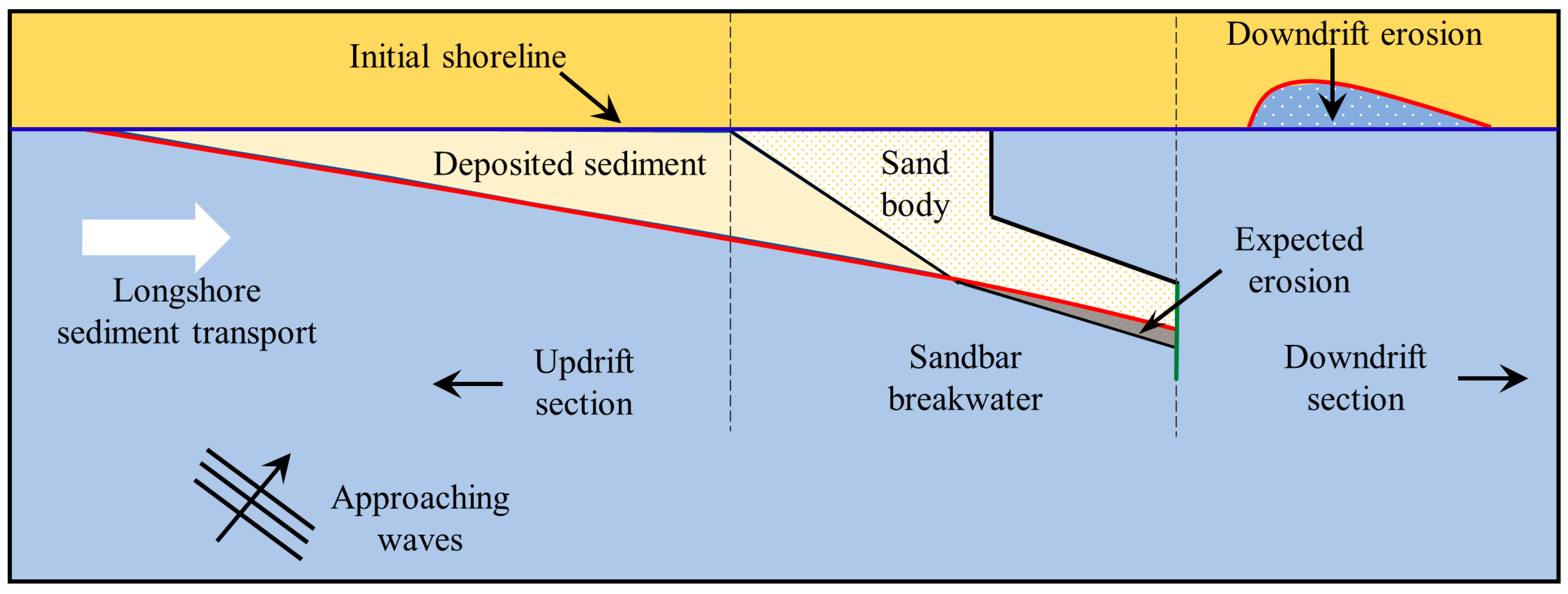

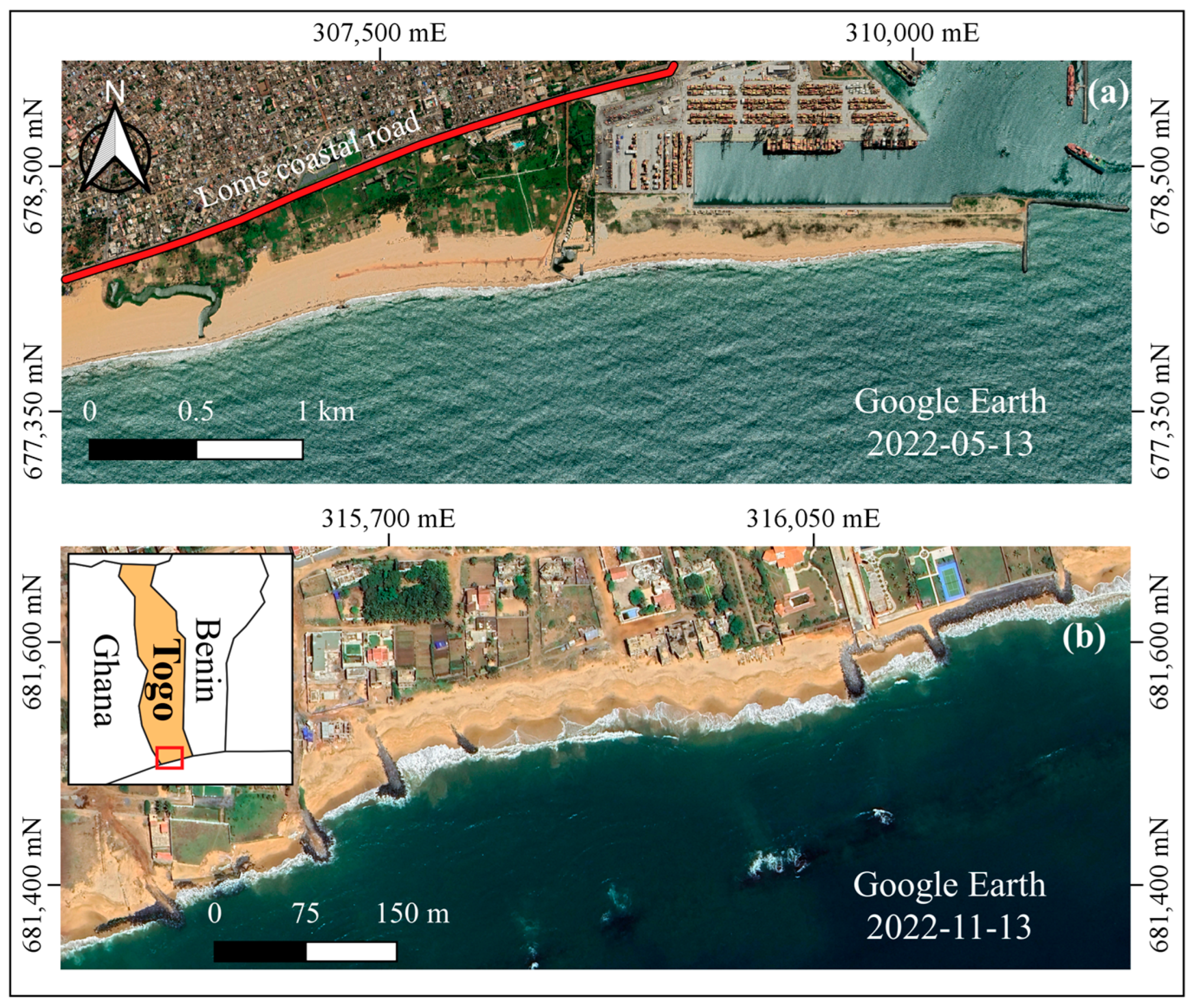

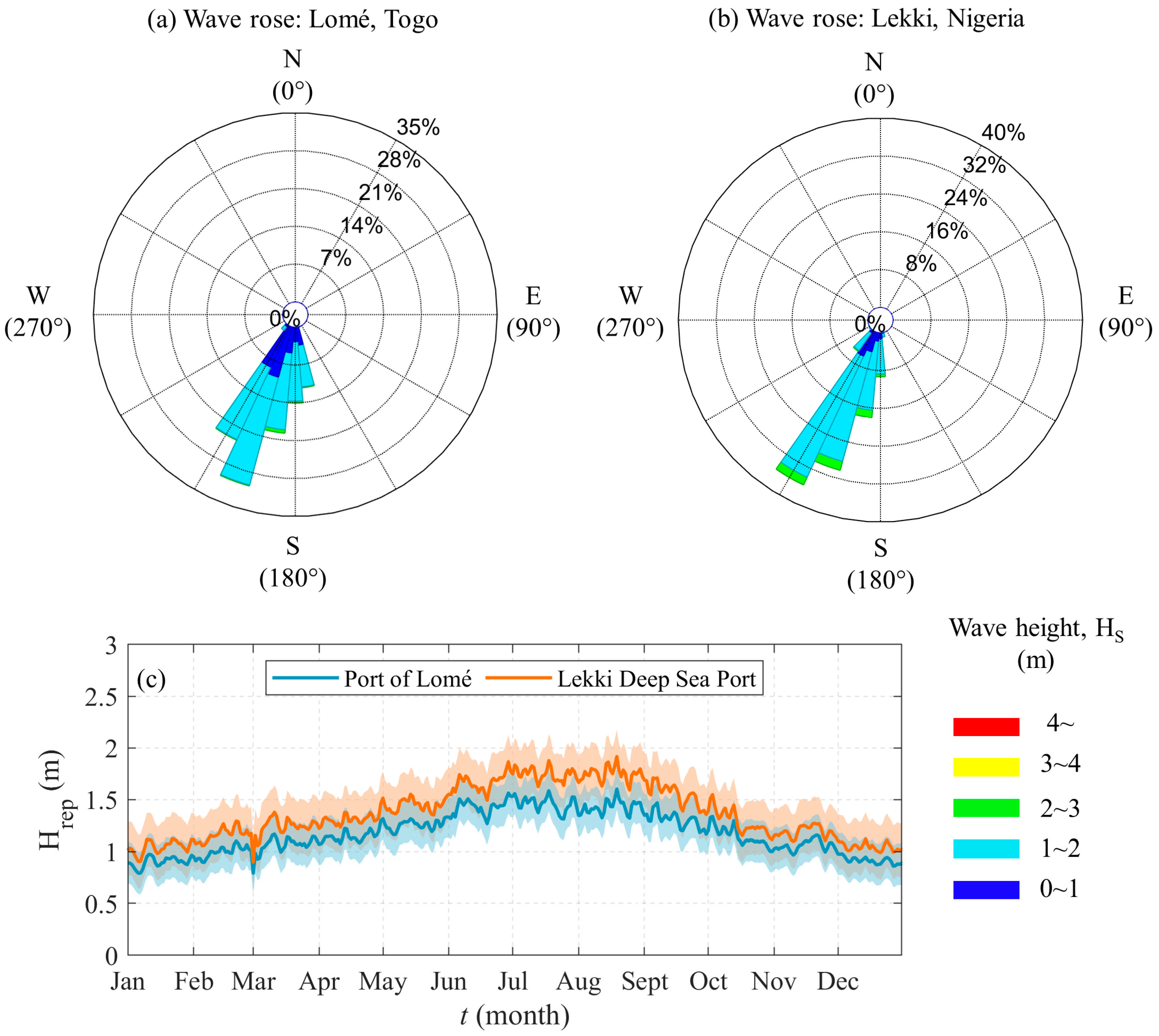
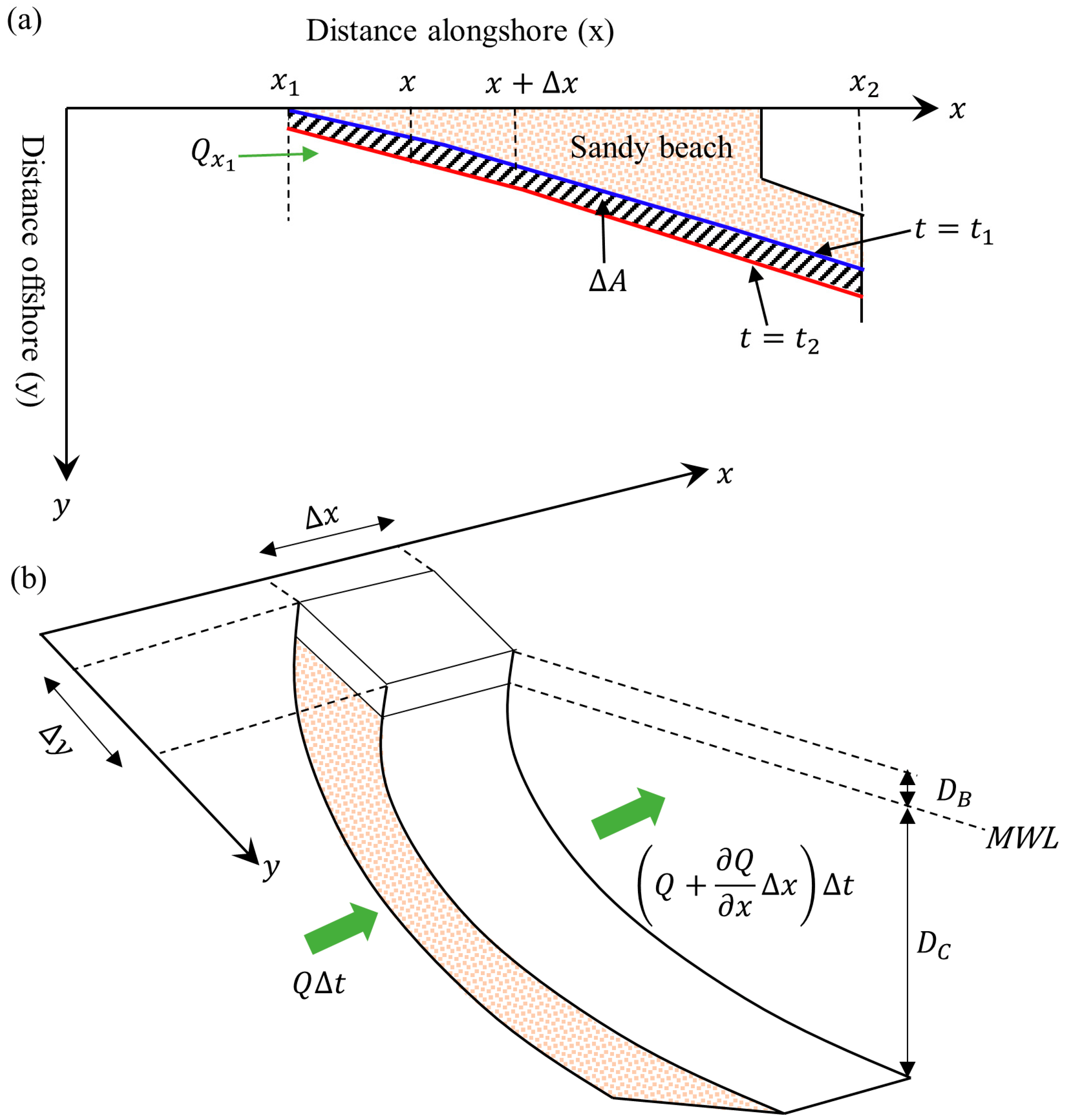
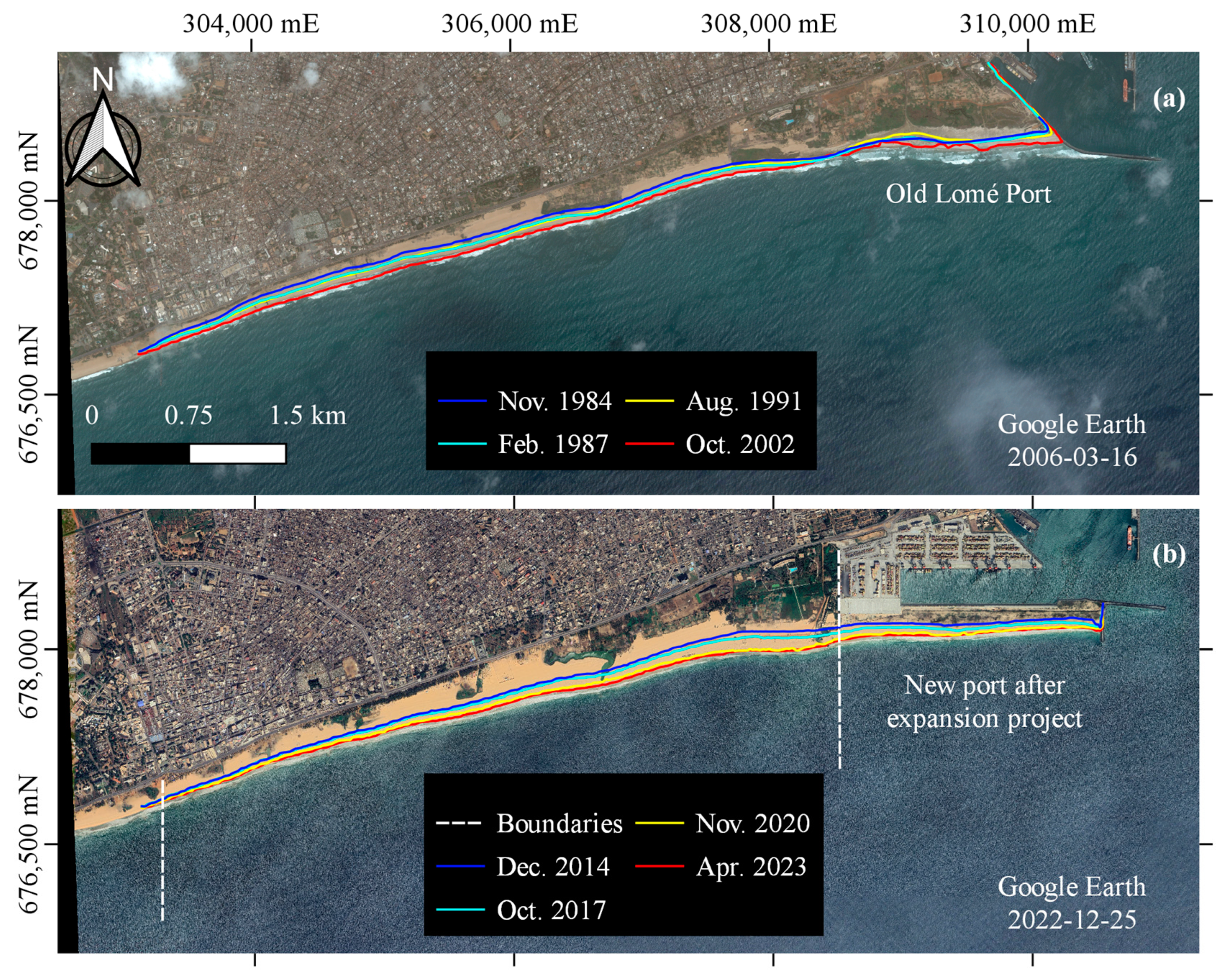

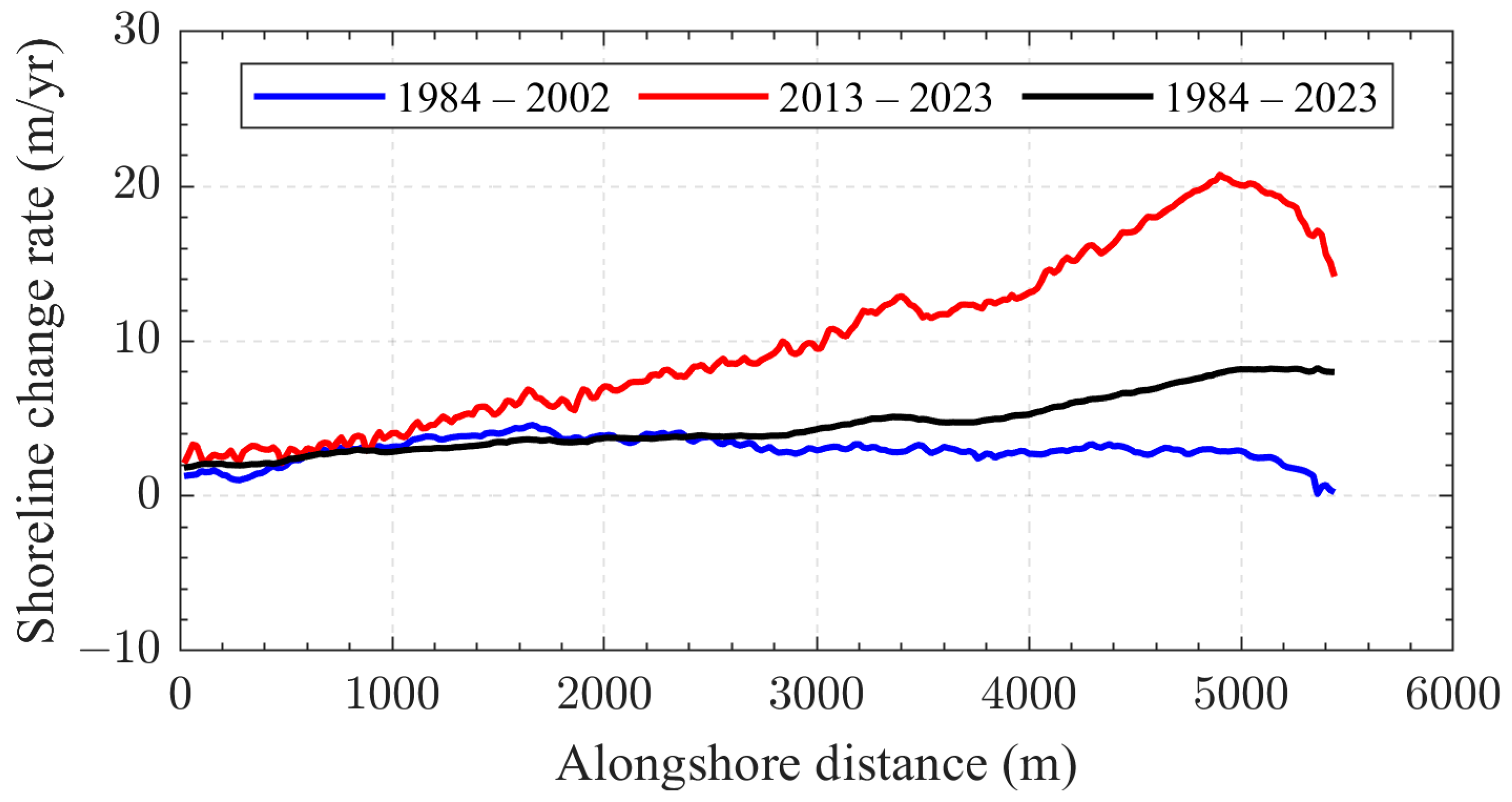



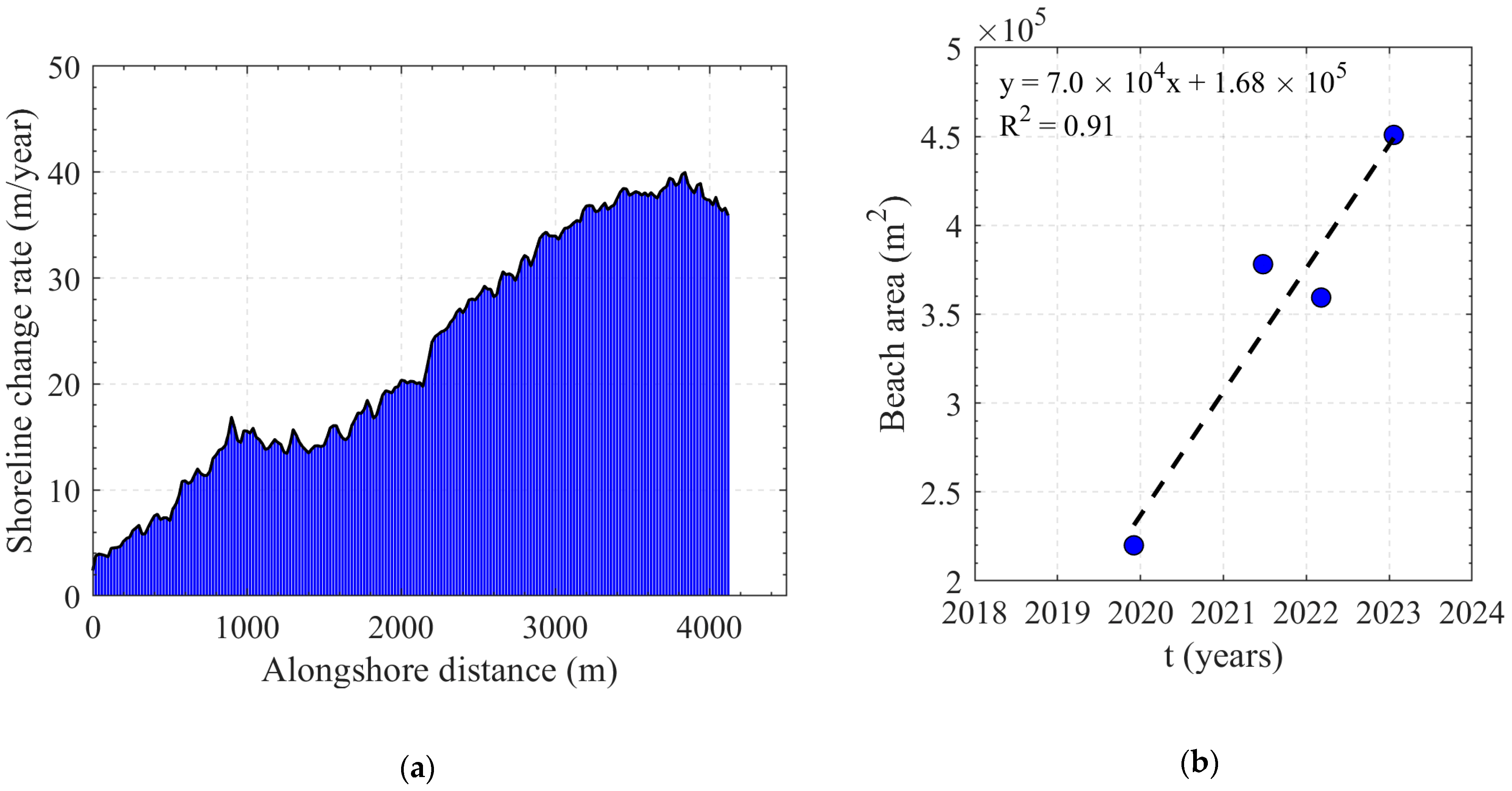
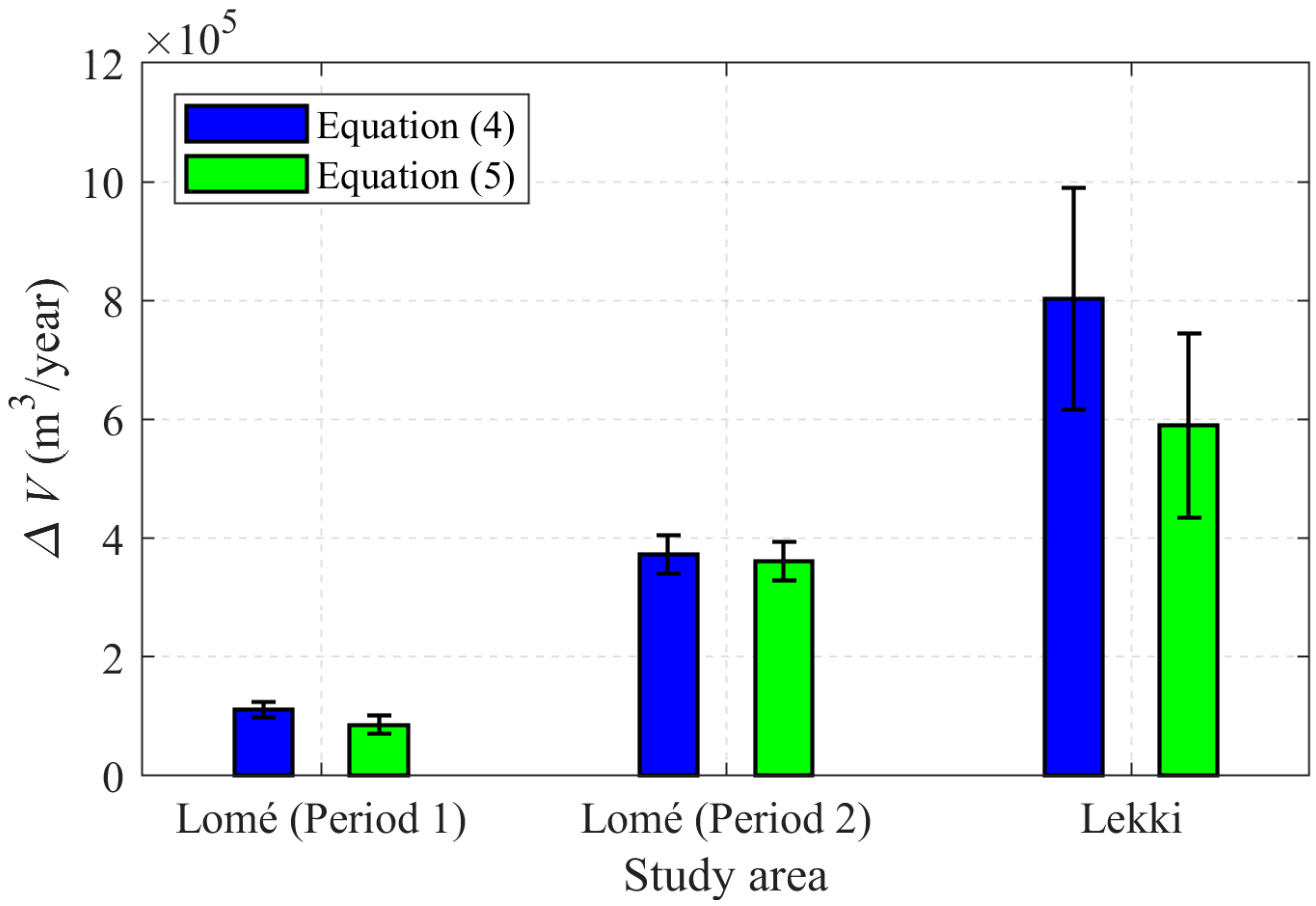
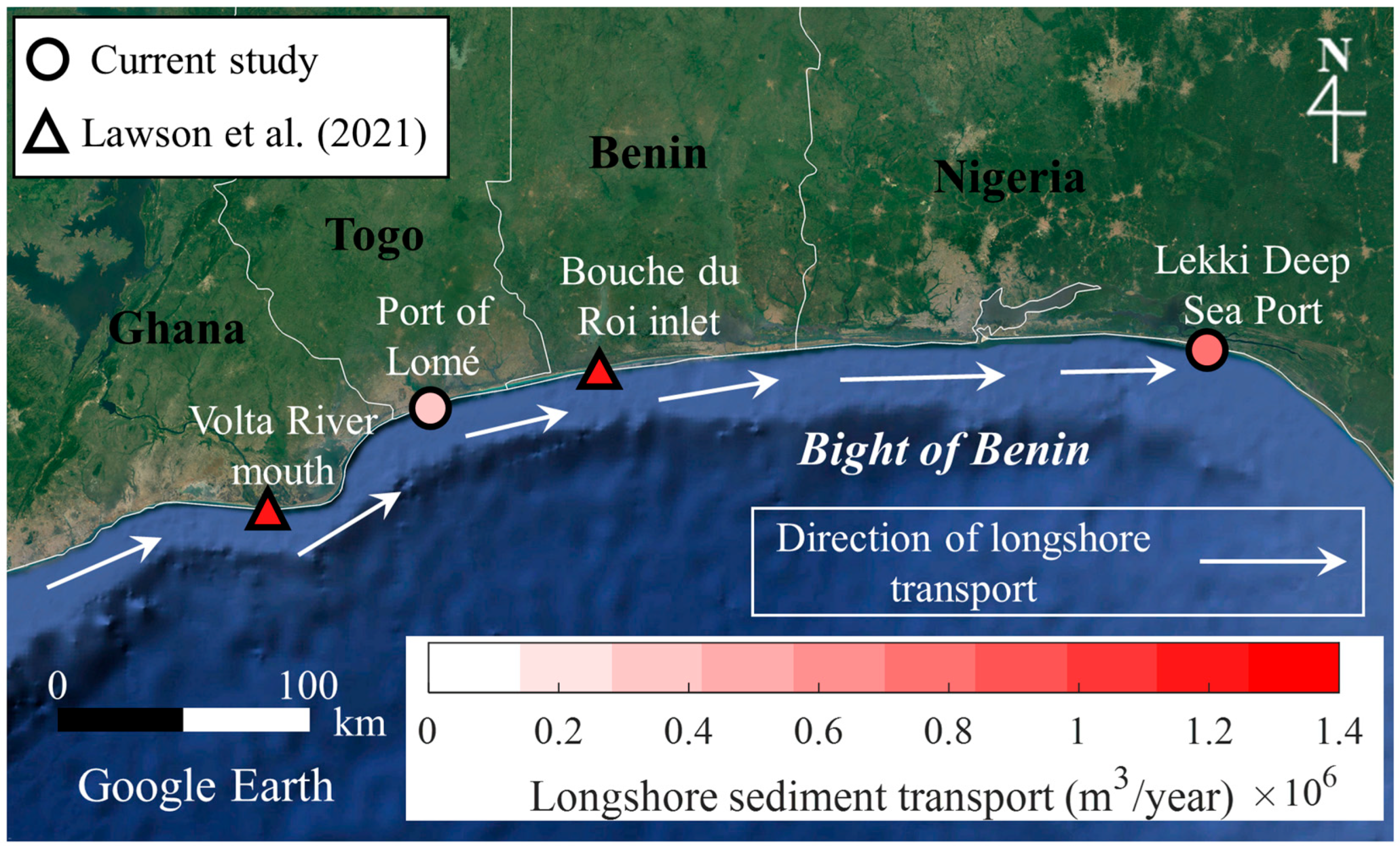
Disclaimer/Publisher’s Note: The statements, opinions and data contained in all publications are solely those of the individual author(s) and contributor(s) and not of MDPI and/or the editor(s). MDPI and/or the editor(s) disclaim responsibility for any injury to people or property resulting from any ideas, methods, instructions or products referred to in the content. |
© 2023 by the authors. Licensee MDPI, Basel, Switzerland. This article is an open access article distributed under the terms and conditions of the Creative Commons Attribution (CC BY) license (https://creativecommons.org/licenses/by/4.0/).
Share and Cite
Lawson, S.K.; Udo, K.; Tanaka, H.; Bamunawala, J. Littoral Drift Impoundment at a Sandbar Breakwater: Two Case Studies along the Bight of Benin Coast (Gulf of Guinea, West Africa). J. Mar. Sci. Eng. 2023, 11, 1651. https://doi.org/10.3390/jmse11091651
Lawson SK, Udo K, Tanaka H, Bamunawala J. Littoral Drift Impoundment at a Sandbar Breakwater: Two Case Studies along the Bight of Benin Coast (Gulf of Guinea, West Africa). Journal of Marine Science and Engineering. 2023; 11(9):1651. https://doi.org/10.3390/jmse11091651
Chicago/Turabian StyleLawson, Stephan K., Keiko Udo, Hitoshi Tanaka, and Janaka Bamunawala. 2023. "Littoral Drift Impoundment at a Sandbar Breakwater: Two Case Studies along the Bight of Benin Coast (Gulf of Guinea, West Africa)" Journal of Marine Science and Engineering 11, no. 9: 1651. https://doi.org/10.3390/jmse11091651
APA StyleLawson, S. K., Udo, K., Tanaka, H., & Bamunawala, J. (2023). Littoral Drift Impoundment at a Sandbar Breakwater: Two Case Studies along the Bight of Benin Coast (Gulf of Guinea, West Africa). Journal of Marine Science and Engineering, 11(9), 1651. https://doi.org/10.3390/jmse11091651







